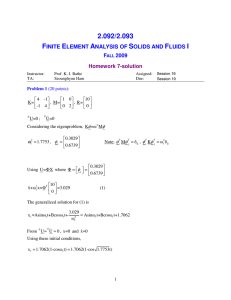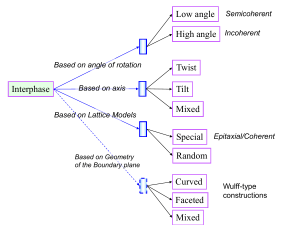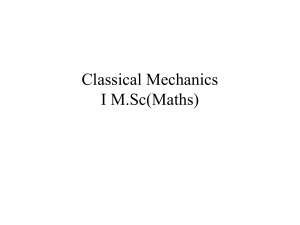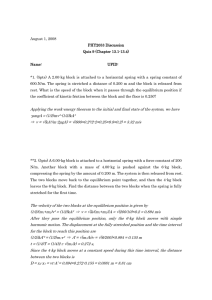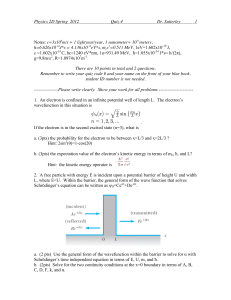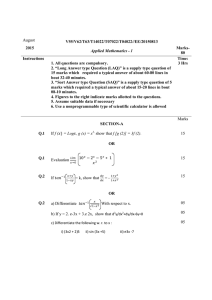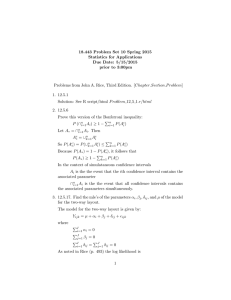Document 13486022
advertisement
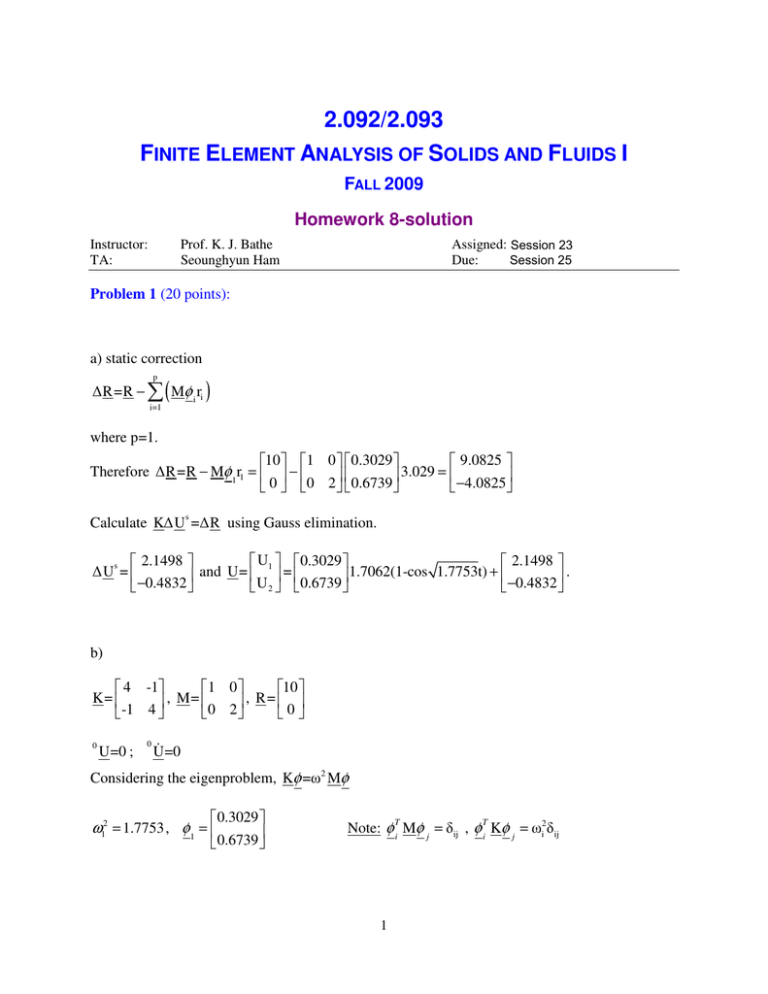
2.092/2.093 FINITE ELEMENT ANALYSIS OF SOLIDS AND FLUIDS I FALL 2009 Homework 8-solution Instructor: TA: Prof. K. J. Bathe Seounghyun Ham Assigned: Session 23 Session 25 Due: Problem 1 (20 points): a) static correction p ΔR=R − ∑ Mφ i ri ( ) i=1 where p=1. ⎡10 ⎤ ⎡1 0 ⎤ ⎡ 0.3029 ⎤ ⎡ 9.0825 ⎤ Therefore Δ R=R − Mφ 1r1 = ⎢ ⎥ − ⎢ 3.029 = ⎢ ⎥ ⎢ ⎥ ⎥ ⎣ 0 ⎦ ⎣0 2 ⎦ ⎣ 0.6739 ⎦ ⎣ −4.0825⎦ s Calculate KΔU =ΔR using Gauss elimination. ⎡ U ⎤ ⎡0.3029 ⎤ ⎡ 2.1498 ⎤ ⎡ 2.1498 ⎤ s ΔU = ⎢ and U= ⎢ 1 ⎥ = ⎢ 1.7062(1-cos 1.7753t) + ⎢ ⎥ ⎥ ⎥. ⎣ −0.4832 ⎦ ⎣ −0.4832 ⎦ ⎣ U 2 ⎦ ⎣0.6739 ⎦ b) ⎡ 4 -1⎤ ⎡1 0 ⎤ ⎡10 ⎤ K= ⎢ , M= ⎢ , R= ⎢ ⎥ ⎥ ⎥ ⎣-1 4 ⎦ ⎣0 2 ⎦ ⎣0⎦ 0 U=0 ; 0 � U=0 Considering the eigenproblem, Kφ =ω2 Mφ ⎡ 0.3029 ⎤ ⎥ ⎣ 0.6739 ⎦ ω12 = 1.7753 , φ 1 = ⎢ T T Note: φ i Mφ j = δij , φ i Kφ j = ωi2 δij 1 ⎡ −0.9531⎤ ω22 = 4.2247 , φ 2 = ⎢ ⎥ ⎣ 0.2142 ⎦ Using U=ΦX where Φ = ⎡⎣φ 1 φ 2 ⎤⎦ 2 �� + ⎢⎡ω1 X ⎣0 0⎤ ⎡ 3.029 ⎤ T ⎡10 ⎤ X=Φ ⎢ ⎥ = ⎢ ⎥ 2⎥ ω2 ⎦ ⎣ 0 ⎦ ⎣ -9.531⎦ (1) The generalized solution for (1) is 3.029 ⎤ ⎡ Asinω1t+Bcosω1t+ 2 ⎥ ⎢ ω1 Asinω1t+Bcosω1t+1.7062 ⎤ ⎡x ⎤ ⎥ = ⎢⎡ X= ⎢ 1 ⎥ = ⎢ ⎥ ⎣ x 2 ⎦ ⎢ Asinω t+Bcosω t+ -9.531 ⎥ ⎣ Asinω2 t+Bcosω2 t-2.2560 ⎦ 2 2 ⎢ ω22 ⎥ ⎣ ⎦ 0 0 � = 0 , X=0 and X=0 � From U= U Using these initial conditions, ⎡ x1 ⎤ ⎡ 1.7062(1-cosω1t) ⎤ ⎡ 1.7062(1-cos 1.7753t) ⎤ ⎥ ⎢ x ⎥ = ⎢ -2.2560(1-cosω t) ⎥ = ⎢ ⎣ 2⎦ ⎣ 2 ⎦ ⎢⎣-2.2560(1-cos 4.2247t) ⎥⎦ ⎡ 0.3029 −0.9531⎤ ⎡ 1.7062(1-cos 1.7753t) ⎤ Therefore, U= ΦX = ⎢ ⎥ ⎥⎢ ⎣ 0.6739 0.2142 ⎦ ⎢⎣-2.2560(1-cos 4.2247t) ⎥⎦ ⎡ U ⎤ ⎡0.3029 ⎤ ⎡ −0.9531⎤ U= ⎢ 1 ⎥ = ⎢ 1.7062(1-cos 1.7753t) + ⎥ ⎢ ⎥ ( -2.2560 ) (1-cos 4.2247t) ⎣ 0.2142 ⎦ ⎣ U 2 ⎦ ⎣0.6739 ⎦ 2 Figure 1: Comparison of the results for the displacement U1 between (i) and (ii). Figure 2: Comparison of the results for the displacement U2 between (i) and (ii). 3 Discussion: One mode plus static correction solution : ⎡ U ⎤ ⎡0.5168⎤ ⎡ 2.1498 ⎤ U= ⎢ 1 ⎥ = ⎢ (1-cos 1.7753t) + ⎢ ⎥ ⎥ ⎣ −0.4832 ⎦ ⎣ U 2 ⎦ ⎣1.1498 ⎦ Two mode solution: ⎡ U ⎤ ⎡0.5168⎤ ⎡ 2.1502 ⎤ U= ⎢ 1 ⎥ = ⎢ (1-cos 1.7753t) + ⎢ ⎥ ⎥ (1-cos 4.2247t) ⎣ −0.4832 ⎦ ⎣ U 2 ⎦ ⎣1.1498 ⎦ In the one mode plus static correction solution, the static correction term shifts the displacements in such a way that the mean of the displacements is about the mean of the solution using two modes. However, here the two modes need clearly be used to obtain an accurate solution. Problem 2 (10 points): T φ i Cφ j =2ωi ξ i δij (1) C=αM+βK (2) Substitute (2) into (1) φ Ti ( αM+βK ) φ i =2ωi ξ i ω1 = 1.7753 , ω2 = 4.2247 , ξ1 = 0.02 , ξ 2 = 0.10 We obtain two equations for α and β. α +1.7753β = 0.0533 α + 4.2247 β = 0.4111 α = −0.206 , β = 0.1461 C=-0.206M+0.1461K Problem 3 (20 points): a) 4 ⎡ 4 −1 0 ⎤ ⎡2 0 0⎤ ⎢ −1 3 −1⎥ φ = λ ⎢ 0 2 1 ⎥ φ ⎢ ⎥ ⎢ ⎥ ⎢⎣ 0 −1 4 ⎥⎦ ⎢⎣ 0 1 2 ⎦⎥ p(λ)=det ( K - λM ) = −6λ 3 + 44λ 2 − 84λ + 40 = 0 λ1 =0.723 , λ 2 =2 , λ 3 =4.6103 −1 0 ⎤ ⎡ 2.5540 For λ1, ⎢⎢ −1 1.5540 −1.7230⎥⎥ φ 1 = 0 ⎢⎣ 0 −1.7230 2.5540 ⎦⎥ T and φ 1 Mφ 1 = 1 Therefore, φ 1 = [ 0.1832 0.4680 0.3157 ] T T T Similarly for λ2 and λ3 with φ 2 Mφ 2 = φ 3 Mφ 3 = 1 φ T2 = [ 0.6708 0 −0.2236] φ T3 = [ −0.1282 0.6691 −0.7190] T T We now show that φ i Mφ j = δ ij and φ i Kφ j = ωi2 δ ij . φ 1 T Mφ 2 = φ T2 Mφ 1 = 0 ; φ 1T Kφ 2 = φ T2 Kφ 1 = 0 φ 1 T Mφ 3 = φ T3 Mφ 1 = 0 ; φ 1T Kφ 3 = φ T3 Kφ 1 = 0 φ T2 Mφ 3 = φ T3 Mφ 2 = 0 ; φ T2 Kφ 3 = φ T3 Kφ 2 = 0 b) Let x1 = [1 1 1] and find another another M- and K-orthogonal vector by inspection. T Let x 2 = [1 α β ] T 5 ⎡ 2 0 0 ⎤ ⎡ 1 ⎤ then x Mx 2= [1 1 1] ⎢⎢ 0 2 1 ⎥⎥ ⎢⎢α ⎥ ⎥ =2+3α+3β = 0 and ⎢⎣0 1 2⎥⎦ ⎢⎣β ⎦⎥ T 1 ⎡ 4 -1 0 ⎤ ⎡ 1 ⎤ ⎢ x Kx 2 = [1 1 1] ⎢-1 3 -1⎥⎥ ⎢⎢α ⎥ ⎥ =3+α+3β=0 . ⎣⎢0 -1 4 ⎦⎥ ⎣⎢β ⎥⎦ T 1 Therefore, α= 1 7 and β= ­ . 2 6 ⎡ 1 T T x1 = [1 1 1] and x 2 = ⎢1 ⎣ 2 7⎤ − ⎥ are M- and K-orthogonal vectors but are not eigenvectors. 6⎦ Problem 4 (20 points): The starting vectors, ⎡1 1 ⎤ X1 = ⎢⎢1 0 ⎥⎥ . ⎢⎣1 −1⎥⎦ The relation KX 2 =MX1 gives ⎡ 0.925 0.4 ⎤ X 2 = ⎢⎢ 1.7 −0.4 ⎥⎥ ⎢⎣1.175 −0.6 ⎥⎦ Find K2 and M2. ⎡10.475 −2.2 ⎤ ⎡14.2475 −3.52 ⎤ T T K 2 =X 2 KX 2 = ⎢ ; M 2 =X 2 MX 2 = ⎢ ⎥ ⎥ 2.4 ⎦ ⎣ −2.2 ⎣ −3.52 1.84 ⎦ Hence, 6 ⎡0.1926 0.6558 ⎤ 0 ⎤ ⎡0.7267 ⎡ 0.2438 0.2714 ⎤ Λ2 = ⎢ ; Q2 = ⎢ and X 2 = ⎢ 0.4473 0.0567 ⎥⎥ ⎥ ⎥ ⎢ 2.0205 ⎦ ⎣ 0 ⎣ -0.0821 1.0118 ⎦ ⎢⎣0.3357 −0.2882 ⎦⎥ Proceeding similarly, we obtain the following results: ⎡ 0.1842 0.6653 ⎤ 0 ⎤ ⎡ 0.7231 ⎥ X 3 = ⎢ ⎢0.4647 0.0256 ⎥ ; Λ 3 = ⎢ 0 2.0039 ⎥⎦ ⎣ ⎢ ⎥ − 0.3191 0.2512 ⎣ ⎦ After two iterations we have ⎡ 0.1842 ⎤ φ 1 � ⎢⎢0.4647 ⎥ ⎥ ; λ1 � 0.7231 ⎢⎣ 0.3191⎦⎥ ⎡ 0.6653 ⎤ φ2 � ⎢⎢ 0.0256 ⎥ ⎥ ; λ2 � 2.0039 ⎢⎣-0.2512 ⎦⎥ 7 MIT OpenCourseWare http://ocw.mit.edu 2.092 / 2.093 Finite Element Analysis of Solids and Fluids I Fall 2009 For information about citing these materials or our Terms of Use, visit: http://ocw.mit.edu/terms.
